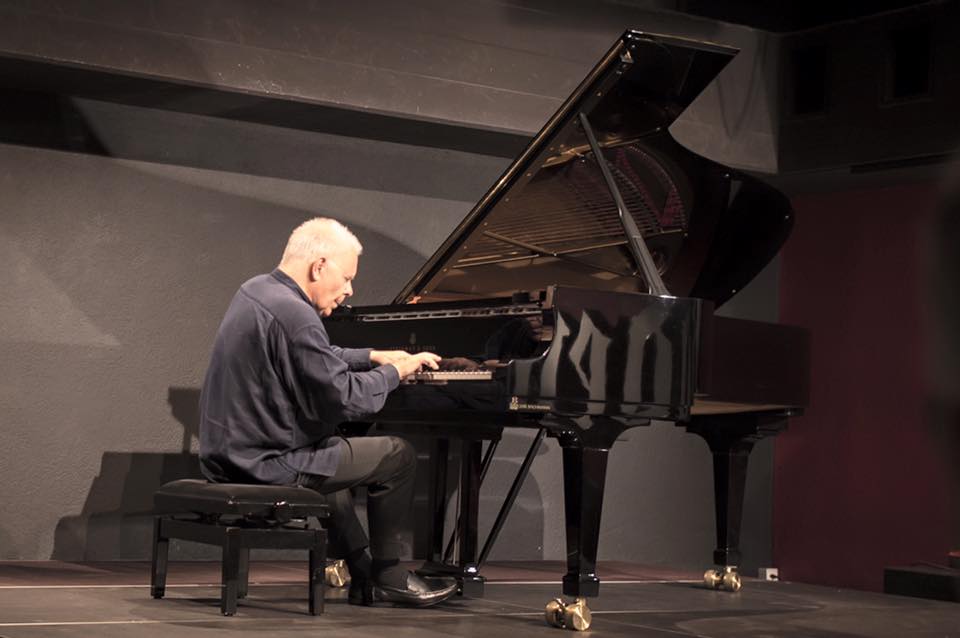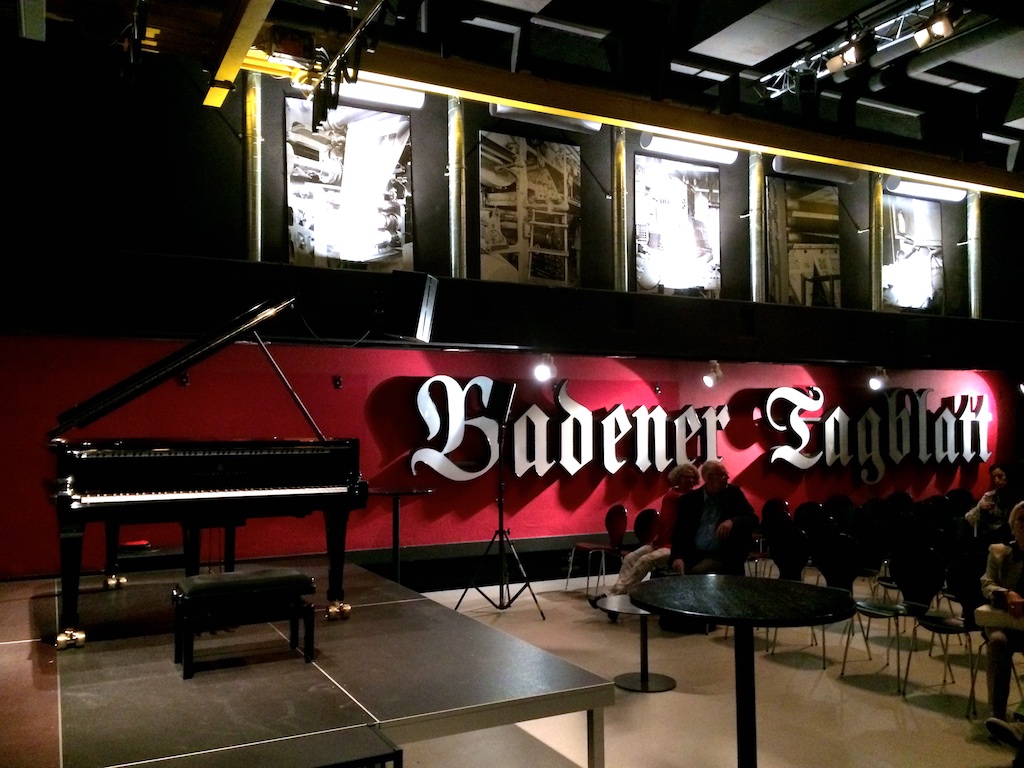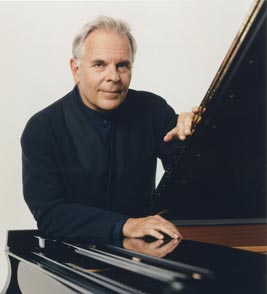Piano Recital: Stephen Kovacevich
Berg, Beethoven and Schubert
Baden, 2015-09-18

2015-09-22 — Original posting
2015-10-19 — Updated CD entry (Mendelssohn / Ilse von Alpenheim)
2016-08-07 — Brushed up for better readability
Table of Contents
- Introduction
- “Piano Legends” in Baden and Wettingen
- Pre-Concert: Ilse von Alpenheim
- The Artist for this Concert
- Performance and Review
- Alban Berg (1885 – 1935): Piano Sonata in B minor, op.1
- Ludwig van Beethoven (1770 – 1827): 6 Bagatelles, op.126
- Ludwig van Beethoven (1770 – 1827): Piano Sonata No.31 in A♭ major, op.110
- Franz Schubert (1797 – 1828): Piano Sonata in B♭ major, D.960
- Encore — Johann Sebastian Bach (1685 – 1750): Partita No.4 in D major, BWV 828 — Sarabande
- Conclusion
- Addendum 1
- Addendum 2
- Addendum 3
Introduction
Organizing piano recitals is a risky business. Especially if the venue is in the province. This concert was in a major agglomeration in the Swiss “Midlands”, only a few km from Zurich, but still! It’s even more risky if the pianist is not one of the very top “hot buttons” such as Martha Argerich, Maurizio Pollini, Yuja Wang, or the like. Sometimes I get the impression that in a provincial setting, the size of the audience oddly tends to be proportional to the number of musicians on the stage. This is not a new phenomenon. When talking to the organizer, I mentioned one incident which I remember very well:
Some 45 years ago, the late Hans Richter-Haaser (1912 – 1980) had given a very successful concert at the Tonhalle Zurich, where he played the Brahms D minor concerto. On the following day he gave a piano recital in Aarau, which I attended. I can still remember the disappointment in his eyes when he saw that only some 5 – 10 rows in the hall were half-filled.
Of course, the artist suffers no immediate damage, as he gets his contractual wage. But the organizer will likely incur a financial loss. The concert in Aarau ended up being a particularly nice and touching one. Maybe because the audience was so small, forming an intimate community with the artist. I remember a very impressive Brahms F minor sonata, and one of the five encores: the shortest of Beethoven’s Bagatelles.
“Piano Legends” in Baden and Wettingen
In this case, the challenge of a piano recital in the province was compounded by the fact that the pianist, Stephen Kovacevich, probably never had a strong presence on stages in Continental Europe (at least, compared to other pianists). Plus, the organizers — jointly Piano District in Baden, and Wettinger Kammerkonzerte — decided to offer a series of four such events within two weeks. This likely caused the events to compete against each other.
Moreover, the series, called “Piano Legends“, (by definition) featured four elder gentlemen: Stephen Kovacevich (*1940), Gérard Wyss (*1944), Paul Badura-Skoda (1927 – 2019), and Philippe Entremont (*1934). The names of these artists are definitely most familiar with people of my generation. But they appear to fade away in the memory of younger audiences. All the more, the organizers’ effort to face the challenge in presenting these artists in a concert series is highly respectable.
The Venue
The venue for the concerts in Baden is a former print shop, in the place where the large rotary print machine producing the local newspaper (Badener Tagblatt) used to reside. See also my post “Yulianna Avdeeva in Baden/CH, 2014-03-08“. The walls and the ceiling of this industrial hall are painted black, there is a bar on the balcony on one side. The wall on the opposite side is partly painted bright red. It carries the emblem of the former newspaper and pictures from the industrial past of that venue.
The room also features the original crane, above the stage. The engine and the rails are painted in bright yellow, creating an industrial atmosphere. This may seem an almost prosaic environment for a concert. Indeed, there is virtually no reverberation. However, that is not needed (nor expected) for a room of that size. Thanks to clever light management, a cosy atmosphere, and intimate community between the pianist and the audience is easily created during a concert.
Pre-Concert: Ilse von Alpenheim
Those who made it to the concert venue at 6 p.m. could witness (and enjoy for free) a 1-hour radio interview with a fifth piano legend. Ilse von Alpenheim (*1927) is an Austrian pianist who has long stopped performing in public, while the other four “legends” still do. She was once well-known for her interpretations of Haydn (she has recorded all piano sonatas), Mozart, and Mendelssohn Bartholdy. The late Antal Doráti (1906 – 1988) was her husband. The most prominent of her recordings is that of Mendelssohn’s “Lieder ohne Worte” (Songs without Words).
The interview was excellently prepared and prudently conducted by Gabriela Kaegi from Swiss Radio SRF Kultur. It was transmitted on the radio on 2015-09-20. I won’t go into details about this here, except for saying that I was (and still am) very, very touched by her recording of Mendelssohn’s Song without Words op.19/1, “Sweet Remembrance” (see below for a CD reference).
The Artist for this Concert
Stephen Kovacevich was born 1940 as Stephen Bishop — a name that he later changed to Bishop-Kovacevich (to avoid confusion with singer and guitarist Stephen Bishop). Ultimately, he changed it to the current one, after his Croatian father. He moved to London at the age of 18 and was a pupil of Dame Myra Hess (1890 – 1965). Interestingly, as part of his debut concert at Wigmore Hall in London, in 1961, he performed the Sonata in B minor, op.1, by Alban Berg, which also opened this concert. In 1974 he married Martha Argerich (they had a daughter, Stéphanie, who was also present in the audience).
… His Playing
The appearance of the artist was modest, if not inconspicuous. Fittingly, he was sitting on an extremely low chair, almost hiding behind the instrument (a Steinway B, see below). The height of his chin was below the rim of the piano, the artist remained totally immersed in an intimate dialog with the keyboard, with closed eyes, listening into the music, talking to it. Indeed, it looked as if he was whispering to the instrument. Especially in the second half of the concert one could hear him humming along with the music.
With such a low position, standard piano technique is hardly possible. Indeed, where one expected his right hand to reach / jump over his left hand, he was moving his right hand below the left arm. Who cares, as long as the result is “right”? Sure, perfection was not to be expected from that evening (and from most artists of that age): sometimes, individual notes (even multiple, occasionally) were missing. Stephen Kovacevich preferred taking such risks, hence avoiding the danger of making the music sound superficial, or too technical through over-articulation.
Performance and Review
Alban Berg (1885 – 1935): Piano Sonata in B minor, op.1
The program started with the Piano Sonata in B minor, op.1 by Alban Berg (1885 – 1935). Berg was one of the key exponents and initiators of the Second Viennese School. His op.1 a composition in a single movement that appears to follow the classic sonata form. Hoewever, it lacks a clear distinction between two different / separated themes. It rather includes elements of a variation movement. The sonata features sections of towering dissonances, tonal clusters. Yet, it remains largely tonal (even though it is devoid of classic cadences).
Stephen Kovacevich closely followed the dynamics in the score. He maintained a rather soft articulation, avoiding harshness, “hard” chords. This wasn’t the virtuosic, high-polish showpiece that one can hear from some other pianists. But still, Kovacevich was able to produce the impressive fff and ffff passages on the Steinway B (a Steinway D does not fit into the elevator, so is not an option with this venue). The playing remained expressive, intimate, internalized: entirely and unmistakably Alban Berg.
Ludwig van Beethoven (1770 – 1827): 6 Bagatelles, op.126
The original program next called for Schubert’s Piano Sonata in A major, D.959. The pianist decided to play Beethoven instead, starting with No.1 and No.6 from the 6 Bagatelles, op.126.
Stephen Kovacevich played No.1 (Andante con moto) carefully, meditating, thoughtfully, accelerating towards the culmination of a phrase, yet often holding briefly at the climax. the articulation remained soft, flowing, with very nice legato. Bagatelle No.6 (Presto — Andante amabile e con moto) featured a singing, poetic, narrative tone. Though the bracketing Presto bars sounded somewhat hurried, overhasty.
Ludwig van Beethoven (1770 – 1827): Piano Sonata No.31 in A♭ major, op.110
The biggest piece before the intermission was Ludwig van Beethoven’s Piano Sonata in A♭ major, op.110.
The first movement (Moderato cantabile molto espressivo) featured natural expression, never appeared “fabricated”, though with a certain tendency towards overusing the sustain pedal. Surely it wasn’t perfect, but always singing.
In the syncopated outer parts of the second movement (Allegro molto), the quaver motifs felt rather compressed, hurried, not articulated properly. Kovacevic did this consequently throughout the movement, though. But then, in the entire movement, one can certainly state that it didn’t feel like playing out of routine, or mechanically, by any means. There was a sense of improvisation in this music.
On the other hand, in the slow movement (Adagio ma non troppo), the recitativo parts were very vocal/talking, narrative, and section annotated Arioso dolente was singing, very expressive.
In the final movement (Allegro ma non troppo), the fugue and its inversion featured soft articulation; Kovacevich took a lot of freedom in the tempo. Though, the rubato always felt natural, never put-on. In both fugue parts, the pianist in my opinion used clearly too much sustain pedal . Especially in the middle part, annotated “Ermattet, klagend” (weakened, lamenting). But I found the last build-up impressive and intense. The artist must have felt the same: his humming indicated how much this music carried him away into the serene, jubilant ending.
Franz Schubert (1797 – 1828): Piano Sonata in B♭ major, D.960
Finally, after the intermission, as “opus summum” in a way, at least in terms of duration: Stephen Kovacevich played Franz Schubert’s last major composition for the piano, the Piano Sonata in B♭ major, D.960.
I. Molto moderato
One could again observe a lot of freedom in the tempo: many artists tend to broaden the tempo towards a climax. Kovacevich rather tended to accelerate during the big build-ups, tightening up the pace. To me, this is a valid option, though not everybody may agree here.
One striking feature in this interpretation was how the pianist could make the instrument sing through the wonderful melodies in the top voice. Also, I liked how he clearly separated the segments of the sonata form (exposition — repeat — development — recapitulation) through prolonged / extended general rests. This helped listeners “staying on track” in this very long movement. In most of the piece, I felt consolation and confidence rather than the sadness and desolation that others may express in this music. There are probably good arguments for both points-of-view.
II. Andante sostenuto
The second movement starts and ends in desperate, longing mood, in loneliness and isolation. Here, the extended use of the sustain pedal is explicitly mandated by the score. For the middle part, the music modulates from C♯ minor to A major. A window seems to open towards the paradise. Interestingly, in the entire concert, this was the only instance where Stephen Kovacevich unconsciously and vaguely looked into the audience, once or twice! But the window to heaven closed again through a very noticeable incision, and inexorably, the music returned to C♯ minor. Nothing in this movement was superficial. It all felt very spiritual, if not ethereal.
III. Scherzo: Allegro vivace con delicatezza
The Scherzo (Allegro vivace con delicatezza) felt rhythmically fluent, never over-accentuated, though some figures sounded like being thrown in sketchily. This may have been the artist’s intent. To me, it sounded almost sloppy.
IV. Allegro ma non troppo
The last movement (Allegro ma non troppo) was played attacca. This is the piece where the artist’s free-floating tempo, his use of rubato were most obvious. Yet, this did not really irritate me here: Stephen Kovacevich presumably never was a “keyboard lion”, an extroverted virtuoso, but rather a subtle, delicate musician. And he still is!
Encore — Johann Sebastian Bach (1685 – 1750): Partita No.4 in D major, BWV 828 — Sarabande
As reward for the warm applause, Stephen Kovacevich sat down again, stating “The tuner and my daughter have requested the same encore; I hope that I remember it!”. He played the Sarabande from J.S. Bach’s Partita No.4 in D major (BWV 828): a very intimate piece with a wonderfully flowing bass line. It was a soothing consolation to take home after Schubert’s desperate last sonata!
Conclusion
To me, this was an inspiring, touching evening — clearly beyond the quest for artistic perfection or polished virtuosity, and I would express my gratitude towards the organizers for making this possible!
Piano Tuning
But I can’t end without mentioning the piano tuner. It is rare that one can enjoy such excellent tuning as in this concert! I talked to the tuner (and provider of the piano) after the concert: Urs Bachmann has worked with Stephen Kovacevich before. He knows exactly what is best for this artist, and for the repertoire in this concert. Over the years, he has developed a tuning (he calls it “very open”, “bright”) that enables artists such as Stephen Kovacevich to make the instrument sing. I was most impressed about the purity and lucidity of (especially major) chords. Also, the tuning persisted extremely well across the entire evening.
Urs Bachmann mentioned that for late-romantic repertoire with thundering double octaves (such as Rachmaninoff), he would need to use a more conventional tuning scheme (as an aside: to my knowledge — he wasn’t specific about his method — this has nothing to do with the tuning temperament, but with gradually stretching / compressing octaves across the range). I did not expect any less, but this was one of the best tunings that I have ever met.
Addendum 1
For the same concert, I have also written a (much shorter) review in German for Bachtrack.com. This posting is not a translation of that German review, the rights of which remain with Bachtrack. I create the German review using a subset of the notes taken during this concert. I wanted to enable my non-German speaking readers to read about my concert experience as well. Therefore, I have taken my original notes as a loose basis for this separate posting. I’m including additional material that is not present in the Bachtrack review.
Addendum 2
The preceding radio interview referred to Ilse von Alpenheim‘s recording of Felix Mendelssohn Bartholdy’s Lieder ohne Worte (Songs without words). The artist is no longer playing in public, so I thought I’d include a reference to that recording, in case you are interested. The pianist Oliver Schnyder (one of the initiators of PianoDistrict), who also participated in the interview, mentioned that during his studies, he first learned about Ilse von Alpenheim through this recording. He stated since that, this CD set has remained one of his very favorite CD recordings ever. Note: the availability seems limited.
Felix Mendelssohn Bartholdy: Lieder ohne Worte (Songs without words)
Ilse von Alpenheim, piano
Philips (2 CDs, stereo); ℗ 1993 / © 1994
Note: limited availability!

For a more detailed discussion of this CD set see my Listening Diary from 2015-10-26.
Addendum 3
In an earlier Blog post, I have compared 10 recordings of Beethoven’s Piano Sonata in A♭ major, op.110. This does not include Stephen Kovacevich’s recording, though.








